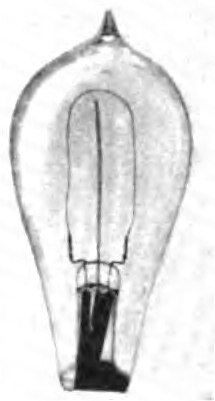Image: Edison effect bulb 1
Description: One of the bulbs Thomas Alva Edison used to discover thermionic emission (the Edison Effect) in 1884. It consists of an Edison incandescent lamp - an evacuated glass bulb with a hairpin shaped bamboo carbon filament - with an additional platinum foil electrode (center, inside the filament) connected to wire terminals. A current is applied to the filament, heating it. Edison found when he connected an ammeter between the filament and the auxiliary electrode, a current would flow, passing through the evacuated space of the bulb from filament to electrode. This current was later found to consist of electrons. This effect is the basis of vacuum tube technology, which dominated electronics for 50 years, until the 1970s.
Title: Edison effect bulb 1
Credit: Downloaded August 17, 2013 from Clayton H. Sharp (January 1922) The Edison Effect and its Modern Applications, Journal of the AIEE, Vol. 41, No. 1, American Institute of Electrical Engineers, New York, p. 69, fig. 2, 10-c on Google Books
Author: Clayton H. Sharp
Usage Terms: Public domain
License: Public domain
Attribution Required?: No
Image usage
The following page links to this image:


